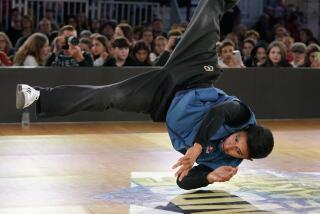Their Competitive Spirits Soar When They Go Fly Their Kites
- Share via
SAN DIEGO — Kite-flying is generally perceived as a recreational activity done mostly by kids at the beach on Saturday afternoons. But a team here has earned five national titles by doing just that--flying kites.
Not kites found at a toy store--diamond-shaped, with cartoon characters on them. Kites flown by the Top of the Line team are manufactured by a San Diego-based company of the same name and are eight feet across and four feet tall. They are dual-controlled--two lines directing them instead of one--and sell for about $200.
Since competitive kite-flying began in 1984, participants have been trying to show that this can be a sport, not just a fun thing to do on a windy day.
San Diegans Eric Streed, Don Tabor and Joel Bargabus are behind it all. One afternoon, they were flying kites down by Mission Bay. Tabor, owner of Top of the Line Kites, was just starting out in the business and brought out a kite much different than those Streed and Bargabus were used to.
“I told him it was too ugly for me,” Streed said. “and that I wasn’t going to fly it.”
But Tabor persisted, bringing three kites the next day, and Streed and Bargabus finally relented. They weren’t used to the dual-controlled kite; because of the dimensions, it tended to “pull,” so the flyers were forced to use more body for control.
“We had fun flying them back and forth in the sky,” Streed said. “The following day, we became more proficient in controlling them.”
Standing shoulder to shoulder, Tabor instructed Streed and Bargabus to follow his kite’s movement. Soon the three were looping their kites in a figure eight. The positioning of the men and the collective movement was the beginning of team kite-flying.
Then they began to experiment. They first tried a 360-degree turn, then a right turn in which their lines would criss-cross, then a left turn to unwrap the lines.
“While we were doing this, a small crowd had gathered behind us,” Streed said. “After we were done, people clapped. I said to Don, ‘We’ve got something here.’ Now it has evolved into a world-wide sport.”
This weekend, for the second consecutive year, San Diego will play host to the Belmont Nationals on Fiesta Island. Teams from across the nation, plus some from Japan, England, Canada and possibly New Zealand, will compete.
Top of the Line has won the national title since 1985, when competition began. The team originally consisted of Tabor, Streed and Bargabus. Since then, Ron Reich, the top-rated male flyer in the world, has joined. In March, Pam Kirk, the world’s best woman flyer, joined after Bargabus left.
Top of the Line has progressed from that first meet, when Reich stood next to the team and read the routine out loud.
“We were really in the stone age back then,” Streed said.
Most teams have either three or four members, but Streed believes having four is a definite advantage.
“One of the main reasons we’re the No. 1 team in the world is because of the fourth person,” Streed said. “It allows us to do more maneuvers and more difficult maneuvers.”
There are both individual and team competitions, and both consist of precision and ballet divisions.
Judging is similar to that of figure skating or gymnastics. Competitors are judged on spacing, timing, continuity, degree of difficulty and overall flow. The point system is on a scale of one to 100.
In ballet, the team flys to music and must coordinate tempo, crescendo and style of music into its routine. Top of the Line continues to win to the tune of “The Battle Hymn of the Republic.”
Streed says ballet judging is highly subjective. Judges must ask themselves: Does the music fit the program? Do the maneuvers match the music, tempo and crescendo? Does the team have a good solid program from beginning to end?
“This is the biggest crowd-pleaser,” Streed said.
In the precision competition, judges concentrate on particular movements.
Reich is the team’s primary choreographer, but everyone contributes.
“Our team is very businesslike,” Streed said. “We’re extremely competitive in our own way. We all have an input, and if it doesn’t work, we’ll go on to something else.”
The team practices three to four hours every Saturday and Sunday and then begins fine-tuning each maneuver a couple of weeks before competition. Practices are video-taped in order to catch flaws in the routines.
Because of the growing number of competitive flyers, Streed said the team must work increasingly hard.
“There are so many younger people starting to do this,” Streed said. “When we first started out, we could just go to competition and fly around. Now, we really work at winning.”
More to Read
Sign up for Essential California
The most important California stories and recommendations in your inbox every morning.
You may occasionally receive promotional content from the Los Angeles Times.













